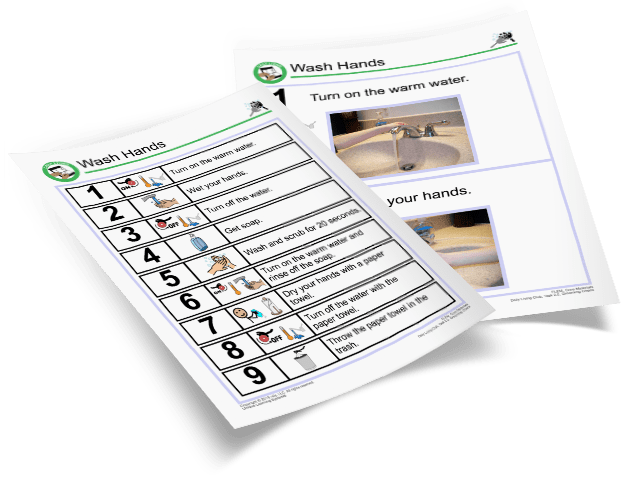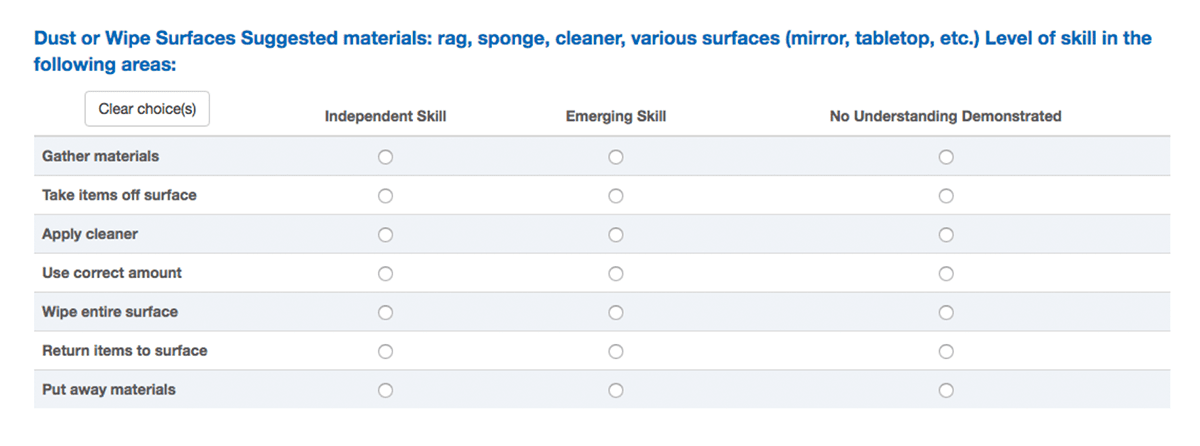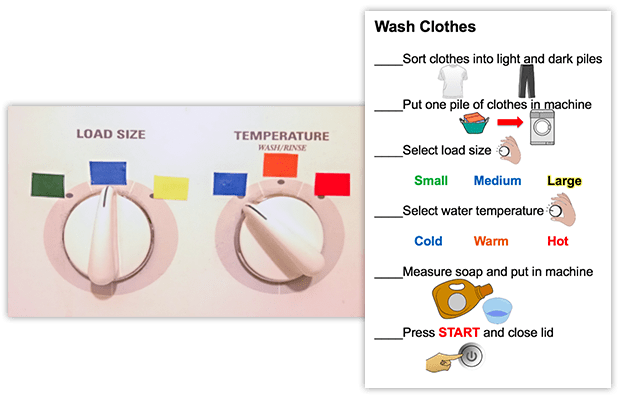Collaborate and make an initial plan
Pass on a list of skills like the one below to families and ask them to think about what skills they may be interested in working on with their child during this time of remote learning. As the teacher, you’ve probably got some ideas based on what you know about their child as a learner in your classroom. Together, brainstorm and choose a few options to try first.
Daily Living
- Dusting
- Sweeping
- Mopping
- Vacuuming
- Watering plants
- Feeding a pet
- Counting and managing money
- Finding information online
- Communicating interests or needs
- Establishing routines
- Devising a safety plan
- Task completion
- Sequencing steps in a task
Laundry
- Sorting laundry (lights vs darks, towels vs clothes)
- Washing clothes
- Putting clothes into dryer
- Folding clothes
- Putting clothes away
- Hanging clothes
Bedroom
- Making a bed
- Taking sheets off the bed
- Changing bed sheets
- Cleaning bedroom
Kitchen
- Sorting refrigerated items vs pantry items
- Putting groceries away
- Setting the table
- Clearing the table
- Wiping the table/counters
- Washing dishes
- Loading the dishwasher
- Unloading the dishwasher
- Making lunch or snack
- Using a microwave/toaster
- Following a recipe
- Sorting recycling
- Sorting dishes or silverware
- Taking out the trash
Hygiene
- Handwashing
- Toothbrushing
- Flossing
- Toileting
- Showering
Self-Help
- Choosing clothes
- Getting dressed
- Putting on socks/shoes
- Tying shoes
- Putting on jacket/zipping jacket
Encourage families to “give it a try” (aka assess to determine baseline)
We teachers are used to conducting assessments in our classrooms to gather baseline data about where to begin academic instruction. Similarly, we can help families think about how to break down daily living skills so that they can better assess what their child is ready to learn. Suggest to families that the best way to determine baseline is by simply having materials available and going for it! Have parents take notes (or even better, conduct this “assessment” virtually with them using an online meeting platform so that you can help analyze a student’s skills and interests).
If you have access to Unique Learning System, then you already have resources for assessing students in each grade band. For preschool–intermediate students, you’ll find cards for handwashing, toothbrushing and much more in Core Materials. Look in Transition Passport for middle school, high school and transition materials.

It can also be helpful to break down a skill using task analysis to gain clearer insights into exactly where a student’s emerging skills might be. When developing a task analysis, think about each step that might be included in a given task and write those out for reference when assessing. Families (with your support) can make notes and observations so they know where their child demonstrates emerging skills and interests.

Incorporate visual supports
After assessing a child’s skills, think about what types of visual cues would enhance their understanding or increase their independence with a skill. Simple highlighting or color-coding as well as picture instructions that show a sequence can be important supports for a student to gain a better understanding of what’s expected. As the teacher, you can create these visual supports and share them electronically with families.

Suggest teaching strategies
Let parents know whether their child typically learns best when a task or activity is modeled or whether they should look for multiple opportunities to practice a skill. Parents won’t necessarily know how to “instruct” their child, so they will be looking for guidance from you. This is a wonderful opportunity to collaborate!
Video modeling works especially well for visual learners. Parents can find instructional videos online, for free or for purchase. They can also make a video of their child performing a task or activity—a smartphone is the only equipment necessary. The child can then watch their video to identify any mistakes made that they can correct.
Extend your teaching
If a student masters the first set of skills they’ve been taught, think of ways to extend the instruction to other skills. Think of the natural next step (i.e., if they’ve learned to sort laundry, can they next learn how to wash clothes?). Perhaps they can generalize the skill of sorting to recycling or silverware.
Remote learning is certainly challenging in many ways, but collaborating and building relationships with families in a whole new way to promote independence and instruction for their children can be exciting and inspiring.



